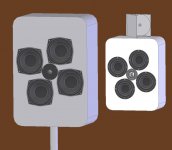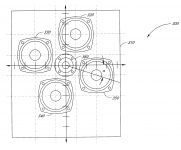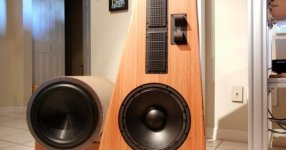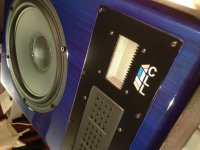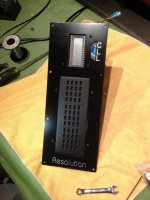Has anyone seen a project where the tweeter is surrounded by a circle of mid drivers? Trying to think my way through whether this would be a benefit for off-axis response/power response/distortion etc.
I do remember seeing a very large example on Linkwitz's site - someone had sent him a photo of perhaps a three-ring Seas Excel-based speaker, but I can't locate the photo at this moment.
Any information would be great.
I do remember seeing a very large example on Linkwitz's site - someone had sent him a photo of perhaps a three-ring Seas Excel-based speaker, but I can't locate the photo at this moment.
Any information would be great.
There's one in Parts Express's project gallery. IIRC, it has dipole or cardioid bass as well.
Sent from my SM-G935V using Tapatalk
Sent from my SM-G935V using Tapatalk
The DNA Sequence is like that:
Then there's this...

An externally hosted image should be here but it was not working when we last tested it.
Then there's this...

Has anyone seen a project where the tweeter is surrounded by a circle of mid drivers? Trying to think my way through whether this would be a benefit for off-axis response/power response/distortion etc.
I do remember seeing a very large example on Linkwitz's site - someone had sent him a photo of perhaps a three-ring Seas Excel-based speaker, but I can't locate the photo at this moment.
Any information would be great.
I played around with that idea some. Mostly on paper (SPEAK could do systems like that). Never got anything that looked impressive enough to try. In all my work I have found that minimizing the number of drivers pays rewards. I still believe that. Complexity just never seems to work out like you want.
DNA pat. US 6,801,631 B1
EAW http://www.fullcompass.com/common/files/18565-Specifications.pdf and another, IIRC, EAW with 6 cones and round horn.
p.s.: cp621, #5 🙂
FoLLgoTT's paper: http://hannover-hardcore.de/infinity_classics/!!!/Dokumentation Quasikoax Prototyp.pdf
EAW http://www.fullcompass.com/common/files/18565-Specifications.pdf and another, IIRC, EAW with 6 cones and round horn.
p.s.: cp621, #5 🙂
FoLLgoTT's paper: http://hannover-hardcore.de/infinity_classics/!!!/Dokumentation Quasikoax Prototyp.pdf
Last edited:
A few years ago, after completing my BG Neo10/Raal 140-15 open baffles, I went on a quest to shrink that speaker, but try to maintain what was special about it. Around that time, the Neo8-S version became available to diy, so I combined it with the smaller Raal 70-20 into a studio monitor. I liked that combo so much, I toyed with the idea of remaking my open baffle but using a group of 4 Neo8-S clustered around the 70-20 using a custom metal faceplate like I had done for the monitor to hold them all as close as possible. Then all of the BG drivers went MIA. Now that they're back at PE, I have that itch again, but need to work on the center channel and surrounds first.
Greg
Greg
Attachments
Using clusters of small drivers instead of one centrally located larger one gives rise to off-axis interference and narrowed directivity at moderate to high frequencies (exactly where this happens depends on how far apart the drivers are). It's very easy to model this in a diffraction simulator to see the nature of the problem.
When I see a system using a short line array, or a cluster of drivers, I can't help but think that the designer is only considering at the "on axis" response. There will be large holes in the off axis response for these designs, and that is generally regarded as B-A-D. This is especially true if the central driver is a ribbon or other tweeter that must be crossed relatively high.
If you need your drivers to be coaxial, then use a coax!
When I see a system using a short line array, or a cluster of drivers, I can't help but think that the designer is only considering at the "on axis" response. There will be large holes in the off axis response for these designs, and that is generally regarded as B-A-D. This is especially true if the central driver is a ribbon or other tweeter that must be crossed relatively high.
If you need your drivers to be coaxial, then use a coax!
If you need your drivers to be coaxial, then use a coax!
 But then coaxes don't work all that well either.
But then coaxes don't work all that well either.That's not quite true, it depends on the sizes. If a ring of small transducers is on the same circumference as the coax woofer then the beam width will be the same, but the coax will be smoother.
It is sad to speak to short-sighted egotistical lemmings, but there is nothing else to do, so concentric is co-axial and symmetric, and Joe D'Appolito found out forty years ago, that a symmetrical arrangement has the advantage, that phase difference between hi- and lopass does not tilt the beam, like it would in an insymmetrical arrangement. Now computers can trade time for phase, hence computer-flawed loudspeakers do not need a symmetrical arrangement, and Follgott's quasi-coax and all that *ergy stuff is redundant. Without a computer, tho, a symmetrical arrangement is the only way to proper multi-waying.
It is sad to speak to short-sighted egotistical lemmings
It's even sadder that you have to speak to others in such a way. Especially since what you are saying makes so little sense.
It is sad to speak to short-sighted egotistical lemmings, but there is nothing else to do, so concentric is co-axial and symmetric, and Joe D'Appolito found out forty years ago, that a symmetrical arrangement has the advantage, that phase difference between hi- and lopass does not tilt the beam, like it would in an insymmetrical arrangement. Now computers can trade time for phase, hence computer-flawed loudspeakers do not need a symmetrical arrangement, and Follgott's quasi-coax and all that *ergy stuff is redundant. Without a computer, tho, a symmetrical arrangement is the only way to proper multi-waying.
A D'Appolito/MTM arrangement of drivers is not the same as some multitude of drivers arranged around a central point. Anyway, D'Appolito's argument for the MTM driver arrangement was based on eliminating the crossover-induced lobing effects that MT systems can have (in the vertical plane). Most MTM systems that I see have the additional problem that the M's are too far apart for the chosen M-T crossover point. As a result, these systems have serious off-axis lobing problems (in the vertical plane) from the M-M interaction - these will occur below and at the crossover frequency. Remember that each time there is a new lobe the acoustic pressure is reversing phase. It's not just that the SPL is varying with position. This is just not good. At least an MTM confines phase/lobing to the vertical plane, where it is less important than in the horizontal plane. Using four or more drivers does not fix these problems - it just multiplies them in new directions. The only "fix" is to choose the frequency for the crossover to the central driver to be very low (in the hundreds of Hertz), which means you cannot use a "tweeter" (although a small fullranger can work well in this application).
If I had seen these multiple-midrange systems around a fullranger I would have given them half a chance. Instead I see this: a picture of some poor guy trying to listen to the speaker in its tiny "sweet spot":

Don't move that head! One of the quotes contains the phrase "They remind me of original Quads.". Now I wonder why that is?
But wait folks... it's a loudspeaker AND a quadriceps workout routine! Get yours today! 😀
Last edited:
- Status
- Not open for further replies.
- Home
- Loudspeakers
- Multi-Way
- Concentrically-arranged mids around a tweeter
